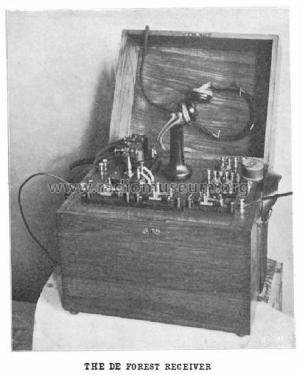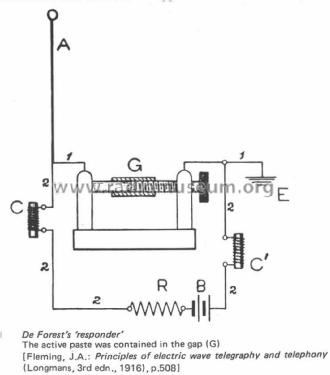Electrolytic Anti-Coherer DeForest-Smythe
DeForest Radio Telephone & Telegraph Co. (De Forest); New York
- Produttore / Marca
- DeForest Radio Telephone & Telegraph Co. (De Forest); New York
- Anno
- 1899–1901 ?
- Categoria
- Modulo per radio pre 1926 (non un particolare, nessun tasto)
- Radiomuseum.org ID
- 278969
-
- alternative name: Lee De Forest Mfg.
- Principio generale
- Ricevitori speciali
- Gamme d'onda
- - senza
- Tensioni di funzionamento
- Batterie (di accumulatori e/o a secco)
- Altoparlante
- - Per cuffie o amplificatori esterni
- Materiali
- Vari materiali
- Radiomuseum.org
- Modello: Electrolytic Anti-Coherer [DeForest-Smythe] - DeForest Radio Telephone &
- Forma
- Soprammobile con qualsiasi forma (non saputo).
- Annotazioni
-
In late 1900, along with W.W. Smythe, de Forest took out a patent for adetector, and called it “the Electrolytic Anti-Coherer.”This detector was constructed like the filing coherer used by Marconi. There were two metal plugs contained in an insulated tube with a gap of about 1/100 inch between them. The gap was filled with one of several mixtures the inventors refered to as "goo". A typical mixture consisted of lead oxide, glycerine, water and metal fillings. The fillings were intended to act as secondary electrodes within the gap. Under the influence of a locally applied direct voltage crystalline lead is produced in such a paste and this builds up into chains and trees across the gap, like the silver particles in Schafer's plate. When a chain is completed deposition ceases as the gap is effectively short circuited. Once again a received pulse of oscillations breaks the chain causing a click to be heard in the telephone receiver which may be connected in the battery circuit.
- Bibliografia
- Western Electrician, July 27, 1901, pages 49-50
- Autore
- Modello inviato da Alan Larsen. Utilizzare "Proponi modifica" per inviare ulteriori dati.
- Altri modelli
-
In questo link sono elencati 158 modelli, di cui 133 con immagini e 16 con schemi.
Elenco delle radio e altri apparecchi della DeForest Radio Telephone & Telegraph Co. (De Forest); New York

